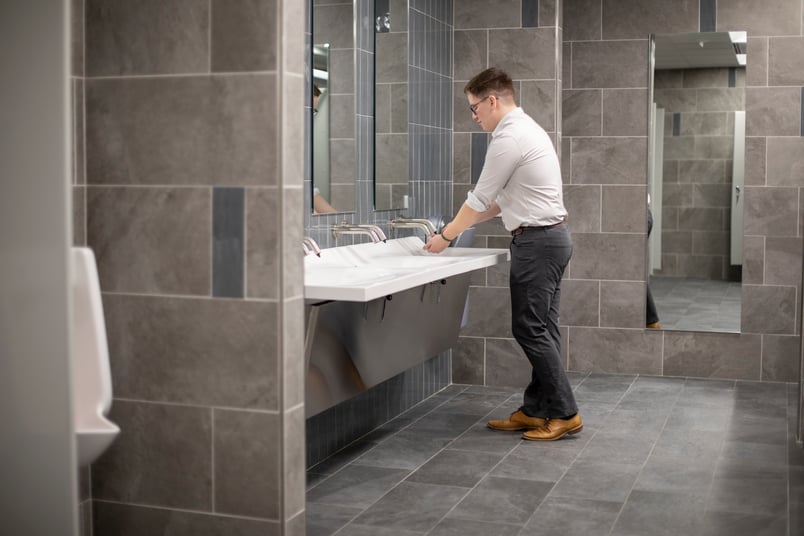
Plumbing continues to make technological advances including in today’s restrooms. Building owners want to give people what they want in a restroom, and they want to save money at the same time.
Restrooms today can notify janitorial and maintenance staff of needs long before someone complains, create a feeling of safety, and lower ongoing costs compared to earlier designs. Newer designs and technology create higher satisfaction for both restroom users and building owners, making these restrooms an easy choice for both new buildings and remodeling projects.
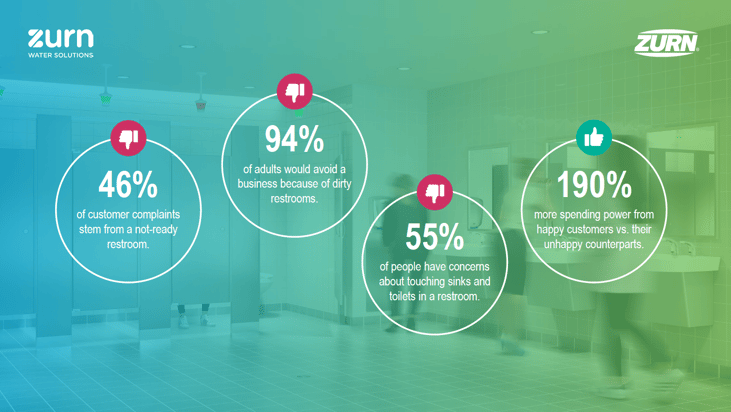
Building Users Want Better Restroom Experiences
Technology has brought every industry into the future, and plumbing is no different. Modern restrooms can help people feel safer and be ecologically responsible, yet what people want goes beyond what was expected just a few short years ago.
Stating the obvious, it is the minimum bar for today’s restroom to be clean and in good working condition. It is no surprise that post-pandemic, people have a heightened awareness of hygiene and germ transmission. More than half of the population (55%) now has concerns with touching sinks or sink fixtures in a public restroom, and almost the full population (94%) will avoid a business with a dirty restroom.
People want a clean and functioning restroom where they feel safe. A restroom that is dirty isn’t just annoying or gross, it assaults the feeling of well-being of those using the restroom. A person starts questioning if their health is affected just by being in a restroom when the restroom is poorly cleaned or maintained. Since perception is as important as reality, even things such as lighting, color choices, and restroom features can affect how users feel about the restroom, and all the elements should be used together to create a feeling of a safe environment.
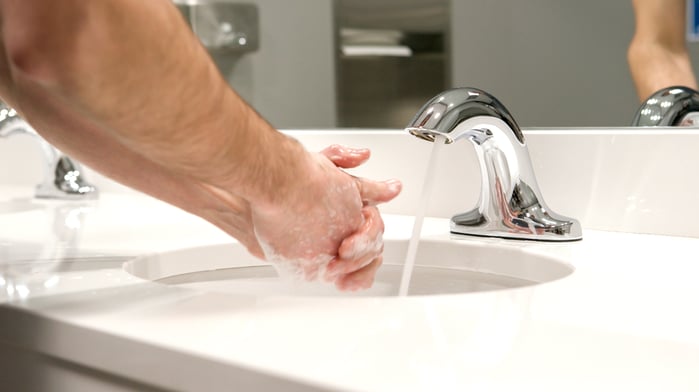
Going Beyond the Minimum Bar in Today’s Restrooms
Restroom users want as touch-free an experience as possible. Sensor-activated faucets, flush valves, and hand dryers are already standard for most public restrooms. Door free entryways remove a final touchpoint after people just finished washing and drying their hands. Eliminating touchpoints gives people confidence they are in a safer environment.
Users want surfaces that are antimicrobial. You can now obtain handwashing systems and toilet partitions that discourage the transmission of germs. Similarly, hand dryers are available with HEPA filters. Make sure signs or labels clearly tell people how the bathroom surfaces protect them. Comfort from users increases knowing the restroom has layers of protection defending them from germs in every way possible.
They want to feel there is room for their “personal space.” With increased sensitivity to the spread of disease, people no longer find it acceptable to use a public restroom shoulder to shoulder with strangers, especially if someone is coughing in the room. Creating a perceived sense of space allows people to feel comfortable in your restroom. Creating perceived space may be from adding physical space, but it may also be from the creative use of partitions, sinks, and other architectural features to create a feeling like someone’s personal space is kept.
They want environmental responsibility that does not trample on their comfort. People would like to know your restroom uses less water and energy, but they don’t want to hear about how great your restroom is if it is at the expense of their experience. Water conservation is great, but the faucet must still give a good handwashing experience. People want a good restroom experience that is also ecologically responsible.
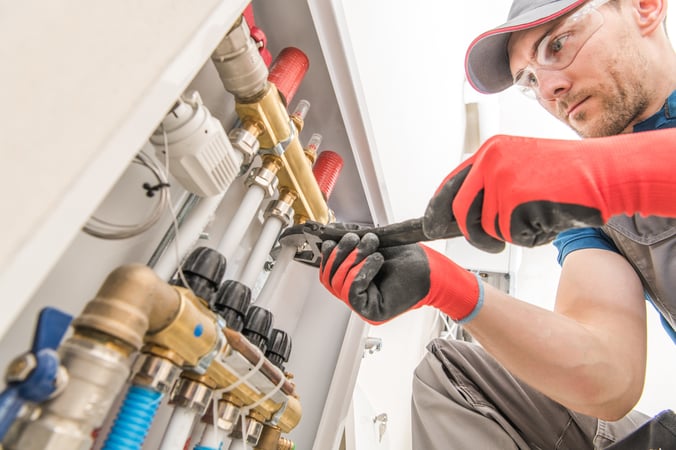
Building Owners Want Less Maintenance and Lower Costs
There has never been a time where a building owner has said, “I wish I had more expenses for my balance sheet,” and we can expect building owners will continue to look for the lowest total cost of ownership. What has changed with the tighter labor market is an increased wage rate for people who clean and maintain the restrooms, especially with skilled trades such as plumbers.
The easy part of the equation is reducing water and paper consumables. Water-saving devices have a direct effect on costs and so does reducing the use of paper products. Today’s hand dryers use less energy to dry hands in less time than older models. New hand dryers often cost less than two to three years of paper towels in a moderate use restroom. We can add, with HEPA filters in today’s advanced hand dryers, users can again have confidence they are safe.
Yet, today’s restrooms need to go beyond reducing water and paper products. Preventive maintenance needs to happen based on fixture use, not an estimated time based on estimated use. It should come as little surprise that some stalls and some sinks in a restroom get higher volume than others. If you scheduled maintenance assuming every fixture received even use, you are swapping parts on some units too early. Heavier use fixtures in the same restroom may fail before PM is scheduled because actual use of the fixture may exceed average or expected use.
What if the restroom could go beyond these obvious savings? What if cleaning schedules were based on actual use of the restroom rather than a rotational schedule based on estimated use? What if the restroom could let you know when there is a fixture problem, while now maintenance staff only find out if there is a customer complaint?
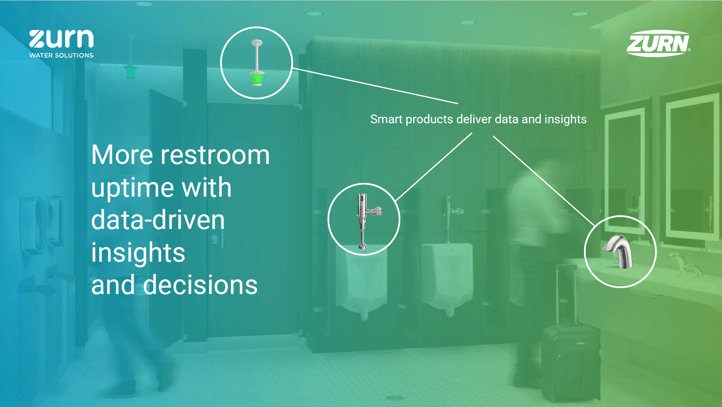
How Zurn Delivers the Restroom of the Future?
It is no longer a zero-sum game choosing between costs or a better experience. Modern technologies allow building owners to supply a better experience AND save money.
One of the largest airports in the United States recently completed a pilot project and is now installing “restrooms of the future” based on Zurn’s connected products platform. Since Zurn supplies every plumbing fixture needed, the fixtures gain cumulative knowledge feeding AI-powered insights giving early indicators something needs intervention. During the pilot project, the airport staff learned about 46 restroom problems over the 107-day trial period before anyone reported a problem to airport staff, which created a better user experience, and the maintenance and janitorial staff responded to real needs rather than blind schedules.
Zurn’s connected restroom also supplies insights into which restrooms need to be cleaned when, as well as staffing insights from actual user data. Staffing can be matched to the actual day of week and hour of day use rather than treating every day the same. Scheduling to actual restroom use almost always creates a reduction in janitorial staffing hours because staff no longer clean low-use restrooms as often as higher use restrooms nor are they cleaning during lower use periods as if it is a higher use period. These insights can be real-time. As an example, janitorial staff at an airport won’t find out about every flight cancellation, but a flight cancellation can create a spike in use for what may normally be a low-use restroom. A connected restroom can inform janitorial staff when there is unexpectedly high use that creates a need for janitorial services earlier than expected.
Zurn’s connected restroom
How does Zurn’s connected restroom know when there is a problem? Connecting all devices together lets the system learn and understand restroom use at a deeper level than ever before. As an example, when the system sees the restroom is busy but one of the sinks is not getting used, a notification goes out to staff so staff can check on that sink and possibly find out the sink was filled with debris. Only when several devices in the restroom are connected into a single system can AI create the insights needed to accurately report problems.
AI-powered restrooms also create new opportunities. Architects and engineers can get insights into how many restroom fixtures are needed in buildings so they can right-size future restrooms for similar buildings. Facility managers can provide hard numbers to justify staffing levels. Healthcare facilities can now measure the effectiveness of handwashing campaigns to show campaign efficacy. Building owners with dispersed locations can minimize travel time by planning out preventive maintenance schedules that concentrate work at nearby facilities or by doing preventive maintenance during a visit for a repair.
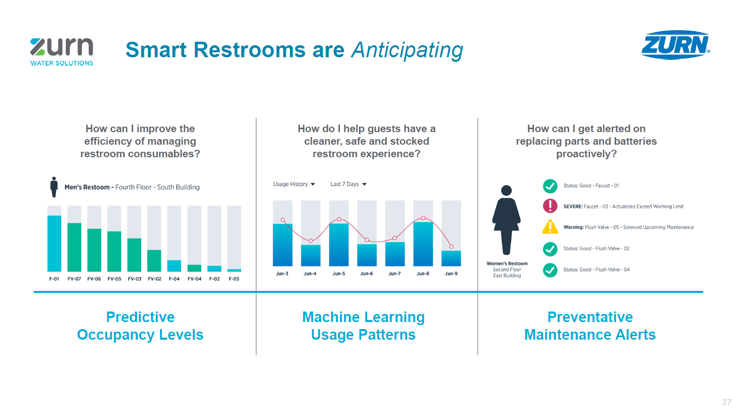
In the end, the connected restroom creates a better user experience because you have a cleaning schedule that matches actual use, and all fixtures are likely to be in good working order. Building owners love it because they save money while giving a better user experience. And we find facilities maintenance and janitorial staff also appreciate it because they are doing the right work, not running around from one emergency to another nor are they working on something that doesn’t really need to be done, like replacing a perfectly good valve just because a calendar said it is time.
We are pleased to provide building owners and users with the restroom of the future. To learn more about the restroom of the future, be sure to check out the Smart Restroom Innovations Whitepaper.






